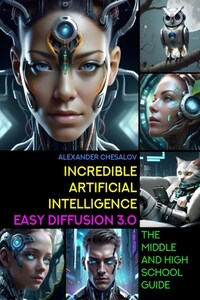Cover designer Alexander Chesalov
Illustrator Alexander Chesalov
© Alexander Chesalov, 2025
© Alexander Chesalov, cover design, 2025
© Alexander Chesalov, illustrations, 2025
ISBN 978-5-0065-8675-8
Created with Ridero smart publishing system
Dear Friends.
I’m happy to present you my new sci-fi short story «Robot Roma: The Last Hope of Humanity».
I dedicate this story to all scientists, programmers, students, pupils and just curious people who are interested in artificial intelligence and robotics. We are living with you in a very interesting time, when modern information technologies allow us to push the limits of human capabilities to explore and learn new things. Today, technology is changing our world, and we are changing with it.
For some reasons unknown to me, in May 2021 I had the unique opportunity to become the person tasked with creating the Center for Development and Implementation of Strong and Applied Artificial Intelligence at Bauman Moscow State Technical University. I gave my all to this work and I am proud that the program of the Center, on which I worked hard, received the highest marks from my colleagues.
During this time, I learned a lot about what scientists think about the prospects of artificial intelligence, how programmers imagine it, and how ordinary people who are concerned about ethics and trust in its results react to it.
You may be surprised to learn that there is no consensus today about the benefits of artificial intelligence and its impact on the future of humanity. Scientists around the world have a wide range of opinions. Some believe that artificial intelligence will destroy humanity, while others, including me, believe that it will change our future for the better, making people more humane and our world more comfortable for people.
In this story, there are many references to my real work experience, the real people I worked with, and the tasks we worked on together. The main characters in the story have their real-life prototypes. And it also has a lot of secret references. I’ll give you one hint, guess what the number «IA 661125» in the name of the robot Roman means.
I also took the liberty of proposing to the reader the Fourth, Fifth, Sixth, and Seventh Laws of Robotics, which run through the entire plot of the story. I first published them in 2020 in my book Digital Transformation.
In my opinion, with the development of modern technologies, people have already reached the threshold where the list of laws of robotics proposed by Isaac Asimov in his works should be completed and implemented in robots.
Modern robotics is developing very intensively, and it won’t be long before various kinds of robots will surround us everywhere, becoming our assistants in households, hospitals, factories and agriculture. Various artificial intelligence systems will be responsible for their consciousness. We will communicate and interact with them. They will become an integral part of our daily lives.
It is now that you and I must pay special attention to these and other current issues of the development and application of modern technologies, so that their use brings only benefits to people.
«Robot Roma: The Last Hope of Mankind» is a deep and emotionally rich science fiction story that explores the problems of human-machine interaction, ethical aspects of the use of technology, and issues of self-awareness. The unique world of the future will not leave you indifferent and will immerse you in an atmosphere of suspense and expectation.
I hope that Roman’s robot story will make you think about the not too distant future, where technology can be both a blessing and a curse for all mankind.
P.S. All the illustrations in the story were created using artificial intelligence. You can learn how to create unique images in my book «Incredible Artificial Intelligence Easy Diffusion 3.0».
Your Alexander Chesalov 07/31/2024.
Robot Roma: the last hope for Humanity
It was the unremarkable year of 2124…
The dark stone room of the underground bunker was stuffy and smelled of musty dampness. Somewhere nearby, large drops of water hit the concrete floor. The bulbs in the dirty, translucent nightlights wrapped in steel wire smoldered dimly.
Huge aluminum control panels with hundreds of colored lights and indicators with rusted metal nameplates adorned the oversized gray concrete walls of the abandoned military bunker of the National Security Planning and Control Command Center.
The damp, warm air had, over the years of neglect, made this work of concrete art look like some unknown artist had mixed colors of lime scale and rust and painted everything around it in whimsical white and red patterns.
All the interior technological decorations of this gloomy room said that this bunker, located in a distant underground city, had not been visited for a long time.
In the darkness of all this reinforced concrete splendor of the past, a humanoid creature sat in a bizarre and somewhat unnatural pose on a large metal chair at a huge table covered with various buttons and joysticks.










